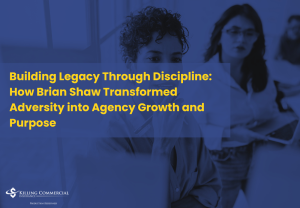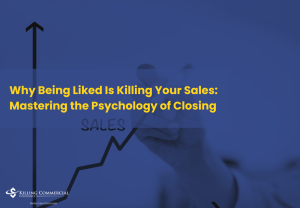How Compliance Conversations and Mod Analysis Can Win You More Middle Market Business – A Conversation with Dustin Boss

Producers can no longer rely on quotes and relationships alone. Middle market prospects are increasingly skeptical of traditional insurance sales approaches. They’ve seen the same pitch from too many agents: “Let me quote your insurance and I’ll save you money.” If that’s your go-to strategy, you’re not just behind the curve—you’re obsolete.
The solution? Stop selling policies. Start solving business problems. Specifically, lead with compliance, risk management, and mod analysis. These tools do more than differentiate you—they give you control of the sales process, open doors with better prospects, and lay the groundwork for deeper, longer-lasting client relationships.
Let’s break down how and why this strategy works—and how you can start using it today.
Why Producers Must Evolve Beyond the Insurance Transaction
For decades, insurance sales have revolved around quoting. But quoting commoditizes the producer, the coverage, and the relationship. If all you’re offering is a cheaper rate or a better dividend plan, you’ve already lost. The buyer controls the process—and they’re often ill-equipped to make the best decision.
Most business owners don’t know how to buy insurance effectively. They’re comparing proposals they barely understand, relying on a spreadsheet of premiums rather than a deep understanding of coverage, risk management, or long-term cost control. The worst part? We created this problem. The industry trained clients to buy based on price, not value.
To stand out, you must flip the script. Teach your prospects how to evaluate insurance advisors, not quotes. Show them the value of selecting a broker based on what you help them prevent—not just what you promise to insure.
Compliance as a Modern Sales Strategy
Compliance and safety aren’t just operational issues. They’re sales opportunities.
By starting the conversation with compliance, you immediately differentiate yourself from agents leading with premium. Tools like OSHA recordkeeping audits, safety training evaluations, and HR policy reviews allow you to talk about real business pain. And unlike a standard proposal, they don’t require a BOR to get started.
Think of these tools as your Trojan Horse. You’re not asking for an appointment to talk insurance. You’re offering to help them fix something that’s broken—or prevent something that could go very wrong.
You’re adding value before you’ve ever asked for a quote. And that changes everything.
The Power of OSHA Logs and Mod Analysis in Prospecting

Let’s talk about two of the most powerful wedges you have at your disposal: OSHA compliance and experience mod analysis.
First, OSHA logs. Most companies don’t know they’re required to file digital submissions by March 2 every year. Even fewer are aligning those records with their workers’ comp data. That’s a massive wedge.
Ask this: “How did it go when your agent helped you reconcile your OSHA log submissions with your work comp claims and submit everything to the federal government?”
More often than not, the answer is a blank stare. That’s your opening.
Now add in experience mod analysis. This isn’t just a number. It’s a grade—one that can add tens or hundreds of thousands to their premiums each year. Show them how their mod impacts profitability. Use reports that break it down by employee or injury. When they see that one injury cost them 43 days of operating profit, you’ve got their full attention.
This is emotional selling—but it’s built on data.
Pre-Renewal Prospecting: Striking While the Bear Sleeps
Most producers prospect 60 to 90 days before renewal. That’s a mistake. During renewal season, the incumbent agent is wide awake and fiercely protective. The best time to prospect? Right after renewal—when the bear goes back into hibernation.
Why would a prospect take a meeting right after they renewed? Something went wrong. Maybe they got hit with a surprise audit. Maybe their quote came in late. Maybe they just didn’t feel supported.
That’s your signal to move in.
Offer to help prepare for their audit. Review their subcontractor certs. Ask if they’ve had a mid-year claims review. You’re adding value when the incumbent is silent. And you’re positioning yourself to take the account next cycle—without ever asking for the BOR.
Turning Loss Runs Into Sales Conversations
If you’re not reading loss runs, you’re missing the best sales script in the game.
Loss runs reveal:
- Lag time in reporting
- Repeat claimants
- Lack of return-to-work protocols
- Gaps in PPE or training
Let’s say you’re calling on an HVAC company and notice four claims for insulation in employees’ eyes. That’s not a coverage issue—it’s a PPE and training issue. Ask them how their agent is addressing it. Chances are, they aren’t.
This is how you create contrast. You’re not quoting—you’re solving. And when the client realizes their agent hasn’t been, the relationship cracks open.
Tools That Help You Lead with Value
You don’t need to invent these tools yourself. Platforms like OSHA Logs, Automate Safety, ModSure, and Compliance Check were built specifically to help producers open doors.
Each one focuses on a specific wedge:
- OSHA Logs: Digital recordkeeping, reporting, and injury tracking
- Automate Safety: Bite-sized safety training delivered by text (no LMS logins required)
- ModSure: Deep analysis of experience mods, cost-per-injury, and controllable premium
- Compliance Check: A 22-point checklist to uncover HR and safety gaps
Give them away. These tools aren’t just differentiators—they’re your new marketing campaigns.
Using the Pilot’s Checklist Approach to Create Credibility

Imagine getting on a plane and watching the pilot skip the pre-flight checklist. Would you trust them?
Your prospects feel the same way about insurance. They want to know their risks are being evaluated thoroughly—even if they don’t always say it.
Use checklists to lead that process. The Compliance Check platform includes modules on:
- OSHA records
- Safety plans
- Lockout/tagout
- Hot work permits
- Hazard communication
- Return-to-work
- Texting and cell phone policies
Every unchecked box is a conversation. Every missing policy is a wedge. And every audit you offer is a chance to deliver real, defensible value.
Overcoming Common Objections with Data and Confidence
One of the most common objections in commercial insurance? “We’ve been with our agent for 15 years.”
Don’t panic. That’s your cue to say: “Perfect. I’m looking for loyal clients like you. I’d love the chance to earn your trust by improving your risk profile.”
Then let the data do the work. If their mod is bloated, if their OSHA records are incomplete, if their handbook is missing key policies—show them. Ask questions that prompt them to say “no,” which actually increases their feeling of control and makes them more receptive.
“Are you 100% confident your OSHA submissions are accurate and up to date?”
“Did your agent help you prepare for your audit last year?”
“Do you know how much your highest-risk employee is costing you in mod dollars?”
Each “no” moves them closer to “yes.”
Putting It All Together: Creating a Winning Sales Sequence
Here’s how to implement this approach step by step:
- Identify prospects with high workers’ comp premiums or hazardous operations
- Initiate with value—offer a compliance check or OSHA audit, not a quote
- Ask strategic questions to surface risk issues their current agent missed
- Provide tools that solve those problems immediately, before the BOR
- Use loss data and mod analysis to connect risk to financial impact
- Stay in the game post-renewal with audit prep and mid-year reviews
- Pivot to insurance only after you’ve built trust and shown value
This process creates pull, not push. You’re no longer chasing quotes—you’re being asked to help.
Final Thoughts: Stop Selling Insurance—Start Solving Problems
If you’re still leading with price, your days are numbered. The future belongs to producers who sell on value, educate with confidence, and position themselves as business advisors—not quote machines.
The best part? This approach doesn’t just win accounts. It builds loyal clients who don’t shop every year, who refer their peers, and who respect the process you bring to the table.
So ask yourself: Are you going to keep quoting and hoping? Or are you ready to start solving and closing?
The middle market is hungry for real help. It’s time to feed them something other than a spreadsheet.

From Confusion to Clarity: How Insurance Agencies Can Unlock Growth Through Strategic Leadership and Culture
In the fast-paced world of commercial insurance, the grind of daily operations often blinds agency leaders to the foundational cracks forming beneath them. Producers are focused on closing deals. Account managers are buried in servicing. Agency principals are juggling leadership, sales, operations, and finance. Yet in the midst of this hustle, many agencies lack the one thing that can unlock the next level of growth: organizational clarity.

Building Legacy Through Discipline: How Brian Shaw Transformed Adversity into Agency Growth and Purpose
Brian’s journey isn’t one of shortcuts or overnight success. It’s the story of a man who has faced battlefields, boardrooms, and hospital beds — and come out the other side with an unshakable sense of purpose. His agency is young, his vision is clear, and his “why” runs deep.

Becoming the Specialist: How Niches, Networks, and Relentless Execution Create Elite Producers
Every producer wants to win. But only a small percentage ever reach the level where winning becomes inevitable—not because they get lucky, not because the market is soft, but because they commit themselves to mastery. They study harder, niche deeper, build better networks, and execute with more consistency than everyone else around them.

Becoming the AI-First Agency: How Insurance Producers Can Leverage Automation to Outpace the Competition
Artificial Intelligence is no longer a buzzword for tomorrow. It’s today’s most powerful tool for increasing efficiency, lowering costs, and growing your book of business faster than ever before. For insurance producers and agency owners, this isn’t a matter of curiosity or a “nice to have” anymore. It’s a necessity. The reality is that your competition may already be using AI-powered tools to identify prospects, streamline service, and close deals before you even realize you’re in the game.

Faith, Empathy, and Opportunity: How Lloyd Brown is Redefining Diversity and Purpose in the Commercial Insurance Industry
In every season of The Protege, one thing becomes crystal clear—success in the commercial insurance industry isn’t about where you start, it’s about who you become.
In this episode of the Power Producers Podcast, I sat down with Lloyd Brown, a middle market producer from Orlando, Florida, whose story is equal parts faith, resilience, and purpose.

Why Being Liked Is Killing Your Sales: Mastering the Psychology of Closing
Salespeople are often taught to be charismatic, friendly, and well-liked. But as David Carothers and high-ticket sales expert Austin Medlin explore in their recent conversation, that mindset could be the very thing sabotaging your close rate. Austin, the founder of CloseSales.com, brings a fresh perspective from outside the insurance industry that perfectly aligns with what commercial producers face daily: buyers who need leadership, not another friend.

Responses